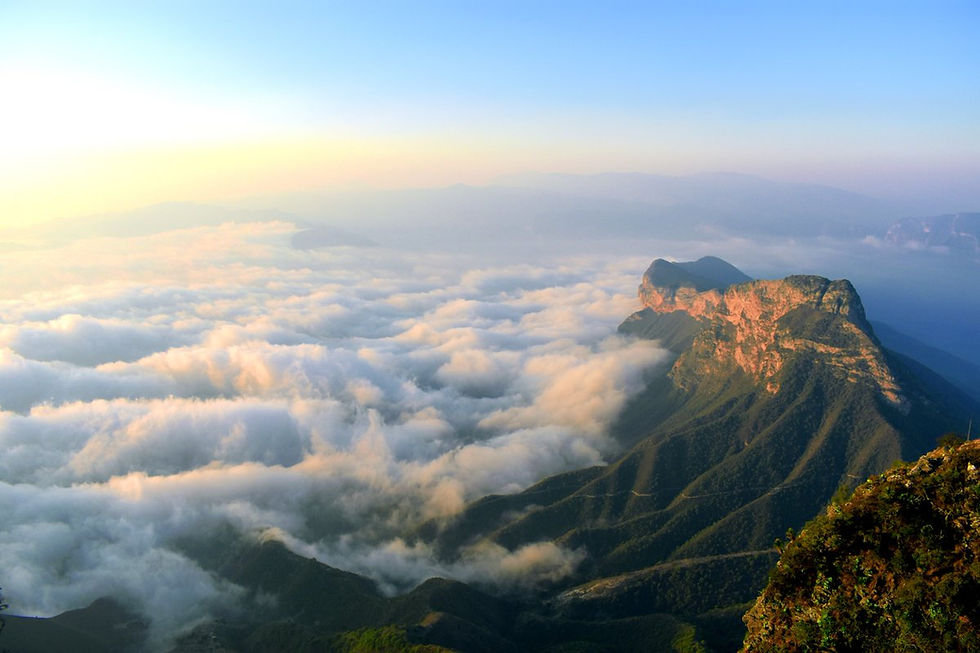Sierra Gorda: How Communities and Nature Built a Shared Future
- Jess Mayes

- Sep 28
- 3 min read

The Sierra Gorda Biosphere Reserve is one of Mexico’s most extraordinary natural treasures. Rising from lowland tropical forests to peaks above three thousand meters, the Sierra Gorda is a land of dramatic contrasts. Eastern slopes receive abundant rainfall, nurturing cloud forests where bromeliads and mosses shimmer with mist. Western slopes lie in rain shadow, giving way to agave, cactus, and thorn scrub. Between these extremes, pine-oak forests and semi-deciduous woodlands knit together a rich patchwork of life.
This compressed geography harbors an astonishing range of species: more than two thousand plants, over three hundred birds, black bears and pumas in the higher elevations, and even the elusive jaguar in remote canyons. Immense limestone caves/ sinkholes, known as sótanos, plunge hundreds of meters into the earth, serving as roosts for swifts, parrots, and bats that emerge each morning in breathtaking spirals. In every season, the Sierra Gorda reminds visitors that they are in a place where the tropics meet the temperate zone, where life has flourished for millennia.
The Birth of a Movement
In 1987, when much of the Sierra Gorda faced deforestation and poverty, a small group of residents decided that the region’s future could be different. This group, led by visionary conservationist Martha Isabel “Pati” Ruiz Corzo, founded Grupo Ecológico Sierra Gorda (GESG). Their goal was audacious: to protect an entire ecoregion while improving the quality of life for the people who called it home.
GESG understood that conservation would succeed only if it included local communities. They began by organizing environmental education programs for children and adults, spreading a message that protecting the land was a shared responsibility. Over the decades, their work grew into a model of community-led conservation recognized by UNESCO and replicated in other biosphere reserves across Mexico.
Regeneration in Action
GESG’s work touches nearly every aspect of the Sierra Gorda’s ecology. They have reforested thousands of hectares of degraded land, created wildlife corridors, and promoted natural regeneration on steep slopes. They developed one of Mexico’s first voluntary carbon sequestration programs, selling verified carbon credits and reinvesting the proceeds directly into rural communities.
Their team has constructed hundreds of check dams and soil conservation structures that slow erosion and recharge aquifers. These interventions reduce flooding downstream and restore the natural hydrology of the region. They have also worked to protect wildlife by partnering with local ranchers, reducing human-wildlife conflict, and encouraging coexistence with species such as puma and jaguar.
Nature and Livelihoods Intertwined
What makes GESG unique is the way they have linked ecology with economy. Their philosophy is simple but profound: the economy is a wholly owned subsidiary of nature. Protecting forests and watersheds is not a cost but an investment that pays back in clean water, fertile soil, and climate resilience.
GESG has helped rural families create microenterprises that complement conservation: beekeeping operations that produce native honey, ecotourism homestays that welcome visitors, nurseries that grow native trees for reforestation projects, and compost businesses that improve soil fertility.
More than four hundred private reserves are now managed by local landowners who receive payments for ecosystem services, turning forest protection into a source of steady income.
Education for the Next Generation
Perhaps one of GESG’s most lasting contributions is its commitment to education. Each year, more than seventeen thousand children participate in ecological education programs, learning about biodiversity, climate change, and sustainable living. These children grow up with a deep sense of responsibility for the Sierra Gorda, carrying conservation values into their families and future careers.
GESG also trains community members as environmental educators, guides, and technicians, ensuring that local knowledge and employment stay rooted in the region.
A Model for the World
The results of three decades of work are visible: forests are returning, wildlife is rebounding, and communities are thriving. GESG has shown that it is possible to reduce poverty and regenerate ecosystems at the same time. Their efforts have earned them international recognition, including the United Nations Equator Prize and partnerships with organizations around the world.
Today, the Sierra Gorda stands as a living example of what community-driven conservation can achieve. It is a place where imagination and ecology meet, where each tree planted and each child educated becomes part of a larger story of renewal.
An Invitation to Participate
The story of the Sierra Gorda is not finished. It continues every day with every tree planted, every reserve managed, every school lesson taught. Visitors are invited to walk its trails, swim in its turquoise pools, listen to the parrots at dawn, and see firsthand what thirty-five years of dedication can accomplish.
Grupo Ecológico Sierra Gorda reminds us that protecting biodiversity is not only about saving species. It is about securing a future where nature and people thrive together.





Comments